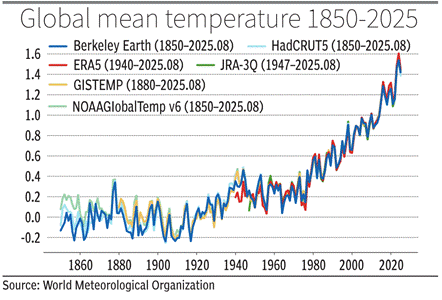Why in News ??
- The World Meteorological Organization (WMO) released its State of the Global Climate Update 2025, warning that 2023–2025 is likely to be the warmest three-year period on record, despite cooling La Niña conditions.
- The period marks a historic acceleration of global warming, with 2025 expected to be among the top 2 hottest years ever recorded.
Relevance
GS-1 (Geography):
- Climatic trends, oceanic processes (La Niña, El Niño) and global heat balance.
- Regional impacts on South Asian monsoon and heat stress patterns.
GS-3 (Environment):
- Global warming data trends — WMO 2025 findings and 1.5°C threshold.
- Carbon budget and emission trajectory relevance for COP30 (Belém Summit).
- Sea-level rise, ocean heat content, and cryosphere loss.
- Reinforces need for India’s Nationally Determined Contributions (NDCs) and renewable transition.

Key Data and Findings (WMO Report 2025)
- Global mean temperature (2023–2025): ~1.4°C above pre-industrial levels (1850–1900).
- Decade 2015–2025: Warmest 10-year span in instrumental record.
- 2024:
- Recorded highest ocean heat content in history.
- 90%+ of excess heat from greenhouse gases absorbed by oceans.
- Sea level reached a new record high.
- La Niña Impact:
- Temporarily cooled global temperature slightly, but warming trend persisted.
- Preliminary 2025 data show a minor decline, but the long-term trajectory remains sharply upward.
Oceanic and Atmospheric Indicators
- Ocean Heat Content:
- Increased steadily since 2023, driving stronger cyclones and coral bleaching.
- Weakens ocean carbon sink capacity → less CO₂ absorption.
- Sea Level Rise:
- Accelerating due to melting of Greenland and Antarctic ice sheets.
- 2024 hydrological year (2023/24): 3rd consecutive record for global mass loss from glaciers (WMO Global Cryosphere Watch).
- Greenhouse Gas Concentrations (2024):
- CO₂ ~423 ppm, CH₄ ~1925 ppb, N₂O ~336 ppb — all record highs.
Regional & Temporal Trends
- Northern Hemisphere: Record heatwaves in 2024–25 (Europe, North America, China).
- South Asia: Warming aggravating monsoon variability and heat stress.
- 2024/25: WMO warns of El Niño–La Niña alternation, amplifying climate unpredictability.
Scientific & Policy Implications
- 1.5°C Threshold:
- UN Secretary-General António Guterres warns world is on track to breach 1.5°C within this decade if emissions continue.
- COP30 (Belém Summit, 2025) stresses need for accelerated decarbonization.
- Carbon Budget:
- Only ~250 Gt CO₂ left (≈6 years of emissions at current rates) before breaching 1.5°C.
- Urgent Warnings:
- Celeste Saulo (WMO Sec-Gen): Rising greenhouse gases make it “extremely difficult” to limit warming below 1.5°C without drastic emission cuts before 2030.
Long-Term Climate Trends
- Since 1850, global mean temperature rose by ~1.3–1.4°C.
- Over 90% of total excess energy trapped by greenhouse gases stored in oceans.
- Anthropogenic warming now overwhelms short-term natural cooling cycles like La Niña.



